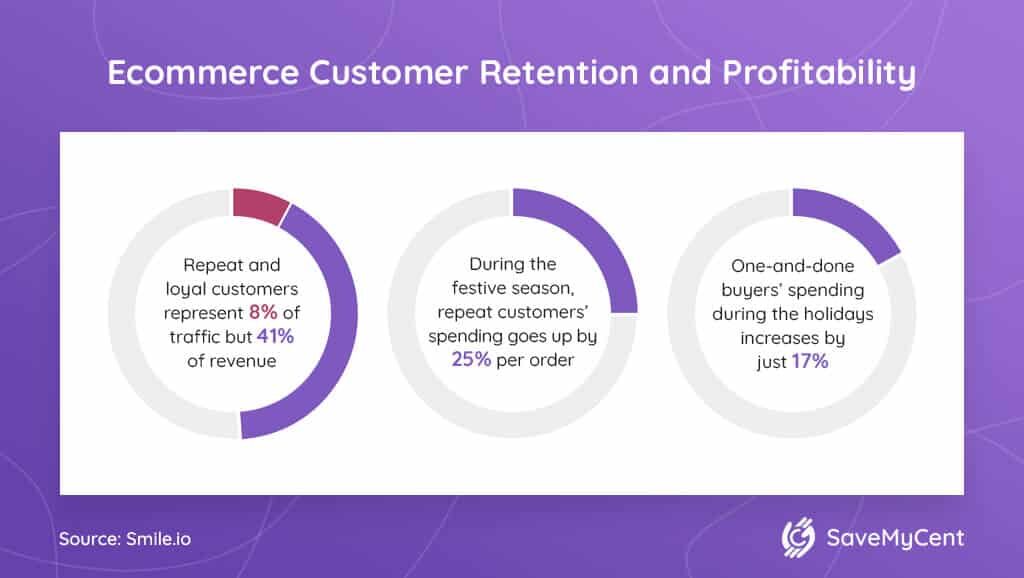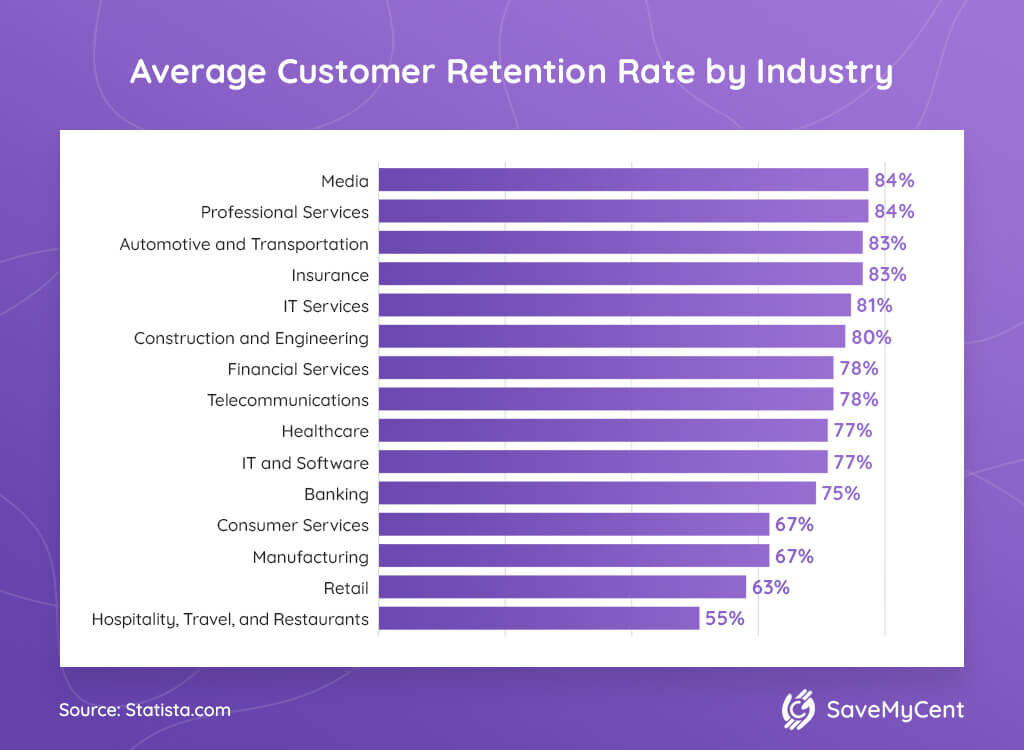As a customer, where will you look for, say, a new pair of shoes?
If you’ve previously bought comfortable shoes from a store or website that offered a pleasant, smooth, and straightforward experience, chances are you’ll look there first. By doing so, you’ll become a repeat customer — and that makes you very valuable for the business in question.
As you’ll see from these customer retention statistics, repeat customers are a company’s most precious asset. Customer retention is all about enticing buyers to purchase again in the future. And retention always goes hand-in-hand with excellent customer experience.
Since the pandemic’s start, most companies have relied on repeat customers to stay afloat. In this overview, you’ll learn why businesses favor customer retention over acquisition. You’ll also find out how companies of all sizes can turn new buyers into returning customers.
Top Customer Retention Stats and Facts (Editor’s Choice)
- The top 1% of customers spend five times more than the remaining 99%.
- 94% of US consumers are highly likely to purchase again from a company that provided an excellent experience.
- Repeat customers spend 31% more than new customers.
- 79% of CMOs are relying on repeat customers to help them get out of the pandemic-related crisis.
- Media companies have an 84% retention rate, the highest across all industries.
- The customer retention rate for ecommerce is 30%, the lowest of all sectors.
- For 85% of B2B buyers, customer experience is as important as a company’s product or service.
- 71% of B2B customers have recently switched to a different company because their values aligned.
- Customer churn costs US companies at least $168 billion a year.
- Banks and cable providers had the highest churn rate in 2020.
Essential Customer Retention Statistics
1. The top 1% of customers spend five times more than the remaining 99%.
(BigCommerce)
Customer retention facts strongly point to the immense importance of investing in repeat buyers. Namely, the most frequent customers tend to leave the fattest checks. Additionally, the top 10% of the most loyal buyers spend up to three times more on a single order than the other 90%.
2. Repeat customers are responsible for 41% of revenue — but only 8% of traffic.

Most ecommerce websites focus on attracting and acquiring new customers, but the traffic they generate doesn’t always equate to spending. Statistics about customer retention show that 92% of shoppers only buy once on any given site — and they spend less than the old, returning customers. For example, during the festive season, repeat customers’ spending goes up by 25% per order, while the average, one-and-done buyers’ spending increases by just 17%.
3. 80% of consumers who left a company say they would have stayed had the company done something differently.
(Accenture)
One of the most encouraging facts about customer retention is that companies can improve buyers’ experiences, thus preventing them from giving up on a service. According to research, building trust is one of the most significant factors in customer retention. Businesses must also focus on multi-service or multi-platform customers and provide a seamless experience for them.
4. Since the pandemic started, 30% of ecommerce platforms that invested heavily in customer experience saw significant increases in customer lifetime value.
(eMarketer)
Customer retention statistics for 2021 show that upgrading experience yields results even in times of crisis. The companies that invested in improving their digital customer experience have boosted customer lifetime value — the total worth of a customer to a business — and customer advocacy by 30% each. Additionally, they saw a 23% increase in the average basket size.
5. For 58% of companies, customer retention was the main reason behind website personalization.
(Yieldify)
In 2020, companies realized the importance of customer retention. In fact, it was their main reason for personalizing their websites, ahead of both conversion (55%) and new customer acquisition (45%). Over the years, numerous studies have found that personalization provides a better experience for online shoppers — and that, by extension, improves customer retention.
6. 94% of US consumers are highly likely to purchase again from a company that provided an excellent experience.
(eMarketer)
If people like a service, they’ll come back for more. It’s just common sense, but the numbers back it up: good customer experience is the foundation of customer retention and loyalty. For comparison, only 20% of customers say they would give another chance to a company that provides a very bad customer experience. According to them, this applies regardless of industry.
Customer Retention vs. Customer Acquisition Statistics
7. Acquiring a new customer costs 5 times more than retaining an existing one.
(Forbes)
While this oft-cited statistic varies depending on the customer acquisition cost (CAC), retaining a customer is usually more economically wise in the long run. As evidenced in the previous stats, existing customers spend more and act as brand ambassadors, recommending it to others.
8. Repeat customers spend 31% more than new customers.
(Invesp)
Customer retention statistics point to the high value of repeat customers, as they are also 50% more likely to try new products. With most consumers shifting to online shopping in times of the pandemic, it is more important than ever for businesses to invest in repeat customers.
9. 70% of business owners say customer retention is cheaper than acquisition.
(Invesp)
According to 89% of business owners, improving customer experience is crucial in boosting the average customer retention rates. It is thus no surprise that 73% of companies worldwide with an “above average” customer service rating outperform their competitors financially.
10. 79% of CMOs are relying on repeat customers to help them get out of the pandemic-related crisis.
(Gartner)
Repeat customers are the lifeline for these CMOs and their companies. Two approaches stand out. On the one hand, 45% of CMOs intend to entice existing customers with new or improved products. On the other hand, 34% plan to keep selling the products they already make.
11. The success rate of selling to a repeat customer ranges from 60% to 70%.
(SuperOffice)
The repeat customer statistics published in the book Marketing Metrics: The Definitive Guide to Measuring Marketing Performance reveal that converting repeat customers is successful in 60% to 70% of the cases. Meanwhile, the chances of converting a new customer range between just 5% and 20%. Of course, this doesn’t mean companies should put all their eggs in either basket.
Average Customer Retention Rate by Industry

12. The media industry has a customer retention rate of 84%.
(Statista)
According to the latest available data, the customer retention rate by industry puts the media in the lead. This is no surprise, especially considering the popularity of audio and video streaming services, whose subscribers rely on them for their favorite shows, music, and podcasts.
13. The customer retention rate in the retail industry is 63%.
(Statista)
The nature of retail is such that customers always have countless options. Also, changing brands doesn’t require any effort, as can be the case with banks, for example. But on the more positive side, this also means that retailers regularly get a steady influx of new customers looking to try new products and services, giving retail plenty of growth opportunities.
14. Banks have an average customer retention rate of 75%.
(Statista, Deloitte)
Bank customer retention statistics show that, on average, US consumers stay with the same bank for 16 years. But there’s more to it than just high customer satisfaction. Namely, switching banks is stressful and time-consuming, so most satisfied customers prefer to avoid the hassle.
15. Hospitality, travel, and restaurants have a customer return rate of 55%.
(Statista, PwC)
While travel enthusiasts love experiencing new things, many remain loyal to hotels that meet their expectations. Of the repeat hotel guests, 76% cite room quality as the deciding factor. Other key considerations include price (69%), location (67%), and loyalty benefits (30%).
16. The average customer retention rate for ecommerce is the lowest at 30%.
(Omniconvert)
Industries that primarily focus on customer acquisition are typically those where customers purchase less frequently. Depending on the niche, online retail generally has a low retention rate, especially compared to physical stores. Still, the competition between ecommerce and retail is fierce, with the brick-and-mortar retailer market dropping to $4.711 trillion in 2020.
17. Telecommunications stock ownership increased retention by 89%.
(PR Newswire, University of Maryland)
Brand loyalty statistics reflect the rising interest in investing and the growth of stock trading apps. Namely, a recent study found that people who invested in a company’s stock increased their spending with the company by 42% over a two-year period. As employee stock ownership becomes more common and young job seekers focus on an employer’s social impact, employer branding could see significant changes.
B2B Customer Retention Statistics
18. B2B ecommerce has a relatively low customer acquisition cost.
(First Page Sage)
For business-to-business (B2B) ecommerce, there’s plenty of fish in the sea. The average customer acquisition cost is only around $81 per customer. This means that B2B customer retention isn’t as big an issue as it is for businesses with high customer acquisition costs.
19. Referred B2B customers have a 37% higher retention rate than acquired ones.
(ThinkImpact)
Referrals are helpful in all business niches but especially in B2B ecommerce. For one, referred B2B customers have a significantly higher retention rate than acquired customers. Additionally, they are 18% more likely to become long-term customers than non-referred clients.
20. 71% of B2B buyers are willing to take their business elsewhere due to bad experiences, customer retention stats reveal.
(Business Wire)
According to a Gallup survey, one in five B2B customers have experienced issues with a company or a product. These customers have also run into obstacles when trying to resolve the issue. Worse yet, only 40% of them say the problem was truly resolved. Finally, just 5% of B2B customers say they’d describe their experiences with B2B sellers as highly satisfactory.
21. For 85% of B2B buyers, customer experience is as important as a company’s product or service.
(Salesforce)
Customer experience isn’t just a priority for direct buyers — it’s a crucial factor for business buyers, too. In fact, customer retention stats show that a satisfying experience makes buyers 91% more likely to purchase from the same company again. And even if they come across a problem, 78% say they would buy again from companies with excellent customer support.
22. 71% of B2B customers have recently switched to a different company because their values aligned.
(Salesforce)
According to recent customer retention statistics, B2B buyers (71%) care more about aligning values than direct customers (59%). In addition, 86% of B2B customers believe a company’s trustworthiness is more important now than before the pandemic hit.
Customer Churn Statistics
23. Customer churn costs US companies at least $168 billion a year.
(CallMiner)
An analysis of customer service calls in the US showed that 36.1% of a total of 586.4 million calls were made to cancel or close an account. But that’s not all: compared to 2018, the churn rate — the number of clients that stop working with a provider — rose by 13%. Also, whereas an average American changed 1.81 providers a year in 2018, that number went up to 2.05 in 2020.
24. An estimated $35.3 billion of the annual churn-related loss is preventable.
(CallMiner)
Customer churn statistics show that improvements in services, experience, and products could help prevent this loss. But with businesses not doing much to fix things amid the COVID-19 pandemic, 63.9% of customers said they planned to change providers. In reality, the churn rate was even higher — 81% of people ended up changing providers in 2020. This difference is the potentially damaging, so-called “unplanned churn,” which was 13% higher than in 2018.
25. Banks and cable providers had the highest customer churn rate in 2020.
(Statista, CallMiner)
At 25%, the financial and cable sectors led the customer losses in 2020. Despite the lockdowns and restrictions, the travel industry only saw an 18% churn, while big-box electronics had the lowest churn rate of 11%. The number-one reason for loyal customers leaving a business is the perceived unfair treatment — a sentiment that has become 24% more prevalent since 2018.
26. The general retail industry’s churn rate is 24%.
(Statista)
Looking at the customer attrition rate by industry, retail is among the top losers. Although the online and offline retail channels differ, both allow customers to switch brands without much hassle. As such, the online retail churn rate of 22% is on par with its offline counterpart. Yet, this isn’t that big a problem, considering the relatively low customer acquisition cost in the sector.
27. One in eight customers has left a gas company due to its unethical behavior.
(CallMiner)
In recent years, we’ve seen a growing number of boycotts aimed at companies that engage in unethical behavior. While this is common across all industries, gas companies are most affected by this. Namely, close to 12.5% of customers have left a gas company due to what they saw as unethical or harmful practices, especially concerning labor and environmental impact.
Customer Retention Facts: In Conclusion
Customer retention helps businesses stay afloat — and it’s even more true in times of crisis. There are numerous perks of investing in repeat customers. Namely, they are more likely to recommend a brand and make a purchase. And when they do buy, they tend to spend more.
The key to retaining customers is customer experience.
Besides reliable products and services, this also includes personalization and — perhaps most importantly — excellent customer care. Simply put, as long as the relationship between a brand and its customers is fair, pleasant, and based on mutual trust, both parties will benefit.
FAQ
What is customer retention?
Customer retention is everything a company does to keep its existing customers. It focuses on growing purchases, improving customer experience, and increasing the average spend on each purchase. The reason is simple — research shows that satisfied repeat customers are highly valuable for businesses. Moreover, these customers help them stay afloat in times of crises.
How to calculate customer retention rate?
When assessing your company’s retention rate for a calendar year, do the following:
- Determine the total number of customers you’ve had during this year.
- Now subtract all the new customers you’ve acquired over the same period.
- Divide the number you get by your total number of customers from a year ago.
- Multiply the result by 100 to calculate the exact percentage.
For example, let’s say you’ve had a total of 500 customers during this calendar year. Of this number, 100 were new customers. A year ago, you had a total of 500 customers, same as this year. Your formula is: ((500-100)/500) x 100 = (400/500) x 100 = 0.8 x 100. This means your average customer retention rate for the current year is 80%.
What is a good customer retention rate?
The ideal retention rate is as close to 100% as possible. On the other hand, 10% would clearly be an issue. However, for most industries, the actual rate is somewhere in between. The best way to find out how you fare is to compare your retention rate to the industry average.
What is the average customer retention rate by industry?
With an average retention rate of 84%, the media industry is in the lead. The banking sector follows with 75%, and retail is in third place with 63%. The hospitality and travel sectors rank second-to-last with 55%, while ecommerce has the lowest retention rate — just 30%.
How many customers become loyal?
While 82% of Americans say they’re loyal to brands and products, 84% say they’re loyal to retailers — both ecommerce and brick-and-mortar. That said, different people have different ideas as to what constitutes customer loyalty. The majority of customers (37%) believe that purchasing from the same brand or store more than five times makes them loyal. At the same time, 33% put the loyalty threshold at three purchases and another 17.5% at four purchases.
What percentage of customers are repeat customers?
As previously explained, the number of repeat customers varies for each industry. According to research, 15% of ecommerce shoppers are return customers. On its own, the number might seem small. However, these 15% of customers are responsible for close to 33% of the total revenue. In addition, they spend up to three times more per purchase than one-off shoppers.
What is the difference between customer loyalty and retention?
The customer retention vs. customer loyalty discussion can often be confusing, as the same numbers can be used to quantify both. However, a retained customer does not always mean a loyal customer. A repeat customer may only be there for temporary convenience, while a loyal customer will pick a brand even if it’s pricier than the competition. The main difference is an emotional connection with the brand — it’s the key element of loyalty.
Why is customer retention important?
Repeat customers indicate the health of a company and the quality of its customer experience. They also spend more, purchase more often, and recommend products to their friends and family. Last but not least, customer retention statistics show it costs significantly less to keep an existing customer than to acquire a new one.
Sources:







![How to Get Free Clothes From Shein? [2024 Guide]](https://savemycent.com/wp-content/uploads/2023/09/How-to-Get-Free-Clothes-From-Shein-336x220.png)
